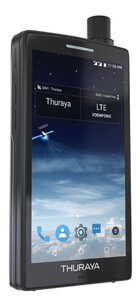Now, connect to satellite through Android
As the mobile phone network expands and it is possible to get a 4G signal atop Mt Everest, you might think the era of satellite phones has come to an end.
Think again. There are all kinds of reasons why satellite phones still come in handy in a ruggedly vertical country like Nepal, where there are still nooks and crannies that lack a mobile signal, or where satphones provide convenient data and voice connections during disasters.

During the war, Maoist guerrillas kept in touch with units across the country through satellite phones. Technology has advanced rapidly since then, and today’s satphones are less bulky, cheaper and have surprisingly affordable service plans available locally.
But the latest, Thuraya X5-Touch, looks nothing like a satphone. It is actually the first Android-based satellite phone that can also be used as a smartphone. It has a 5.6in touchscreen, 2GB of RAM, 16GB of expandable storage, an 8MP rear camera and even a 2MP selfie snapper.
The phone is always on dual mode, with one SIM working on 1G-4G networks where available, while the other SIM connects to a satellite. To make a satellite call, a user simply pulls out the retractable antenna and dials. The beauty of it is that platforms like WhatsApp and Facebook Messenger are on the unit. This phone is ideal for those who make frequent international travels to hard-to-reach places. The set has a price tag of about Rs200,000.
The other popular new model is the Thuraya XT-PRO. Although bulkier than the XT-Lite model introduced three years ago, the PRO is a professional device for real adventurers, or those who work in extremely remote areas.


The phone is as rugged as they come, is fire and waterproof and has a GPS locator, along with a special SOS button for emergencies. The XT-Lite is still popular and available in Nepal, and although it is much cheaper than other satphones at Rs110,000, it does not have data.
Infrequent travellers might consider a Sat Sleeve, which turns an existing smartphone into a satphone via an app. This device has been around for five years, and is still the cheapest, most convenient way to use satellite-based communication.
At Rs70,000 the sleeve allows the mobile to be used as a cellphone as well as a satellite phone when there is no cell signal. The sleeve fits most iPhone models and Androids, and its internet capability is always on for web browsing, email and social media.
Independent import of satellite sets is not allowed in Nepal, so both device and service have to be bought through local providers like Constellation in Sanepa, which has most of the phones and equipment in stock. Its customers are mainly mountaineering expeditions, the United Nations and Kathmandu-based embassies, as well as disaster relief agencies.


UAE-based Thuraya also provides the IP+, a terminal that works as a satellite-based router for data applications over a 10m radius, for up to five devices. It provides WiFi data speeds up to 444kbps and works by pointing the dish to a satellite.
The other popular service offered is the Iridium Extreme PTT (“Push To Talk”), which is essentially a satellite based walkie-talkie. Unlike Thuraya, which uses satellites in geosynchronous orbit, Iridium satellites are in low-Earth orbit. The company has now replaced all its satellites with updated technology, making it possible to offer services like the Extreme PTT.
The only requirement is that both users need to have the same handset, so they can be in constant communication without the need to dial-up. This is perfect for domestic airlines, mountaineering expeditions and hydroelectric projects, or post-disaster rescue and relief, when personnel have to be in constant touch.
Read also: Keep in touch, Kunda Dixit

Constellation has even sold M2M (machine to machine) satellite units that transmit air pollution measurements, glacial lake levels or snow cover data in real time to monitoring stations in Kathmandu.




